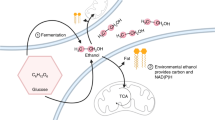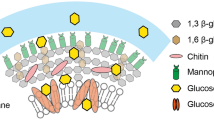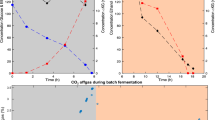Abstract
DURING the fermentation of glucose by yeast, Pulver and Verzar1 showed that potassium was absorbed from the external fluid and released again towards the end of fermentation. Leibowitz and Kupermintz2 showed a similar occurrence in bacteria (B. coli). These workers believed the potassium changes to be specific for this ion, but it was shown by us3 that 'ammonia' yeast in which all the potassium of the cells was replaced by NH4+ behaved in a similar way with respect to the NH4+ ion. An explanation of the process was advanced in which it was considered that potassium entered with phosphate and, this being esterified, held the potassium inside electrostatically, more potassium entering then to equalize the products of potassium and phosphate ion concentrations without and within. Towards the end of fermentation, this process was presumably reversed, and so accounted for the potassium or ammonium released.
This is a preview of subscription content, access via your institution
Access options
Subscribe to this journal
Receive 51 print issues and online access
$199.00 per year
only $3.90 per issue
Buy this article
- Purchase on Springer Link
- Instant access to full article PDF
Prices may be subject to local taxes which are calculated during checkout
Similar content being viewed by others
References
Pulver, R., and Verzar, F., Helv. Chim. Acta, 23, 1087 (1940).
Leibowitz, J., and Kupermintz, N., NATURE, 150, 233 (1942).
Conway, E. J., and O'Malley, E., NATURE, 151, 252 (1943).
Author information
Authors and Affiliations
Rights and permissions
About this article
Cite this article
CONWAY, E., O'MALLEY, E. Nature of the Cation Exchanges during Short-Period Yeast Fermentation. Nature 153, 555–556 (1944). https://doi.org/10.1038/153555b0
Issue Date:
DOI: https://doi.org/10.1038/153555b0
This article is cited by
-
Biological interlinkage of acid-alkali formation with ion transport and synthetic reduction
The Irish Journal of Medical Science (1949)
-
A Theory of the Formation of Hydrochloric Acid in the Gastric Mucosa
Nature (1945)
-
Formation of Hydrogen Ions in High Concentration by Ordinary Baker's Yeast
Nature (1944)
Comments
By submitting a comment you agree to abide by our Terms and Community Guidelines. If you find something abusive or that does not comply with our terms or guidelines please flag it as inappropriate.



